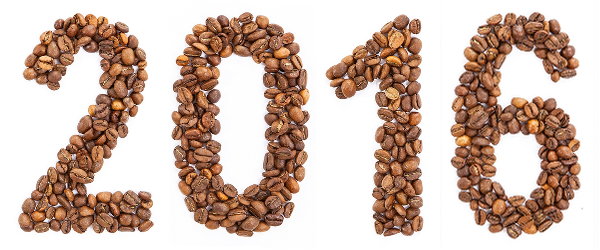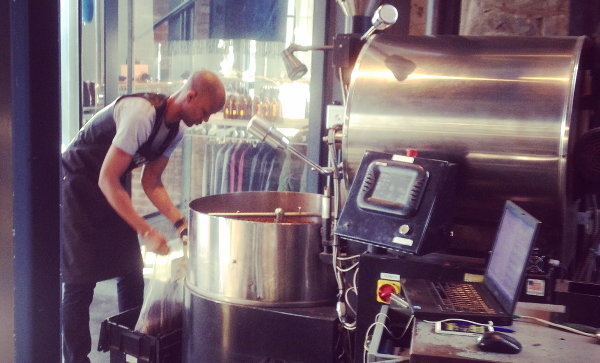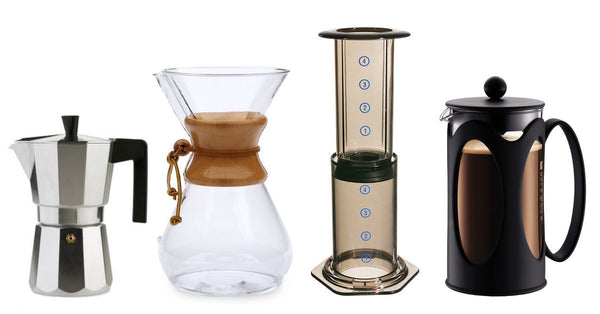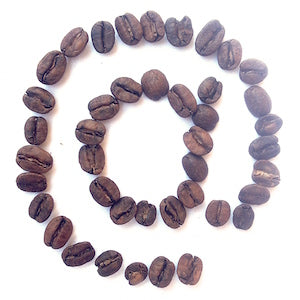2016 was a big year for Cape Coffee Beans - as a business, and also from a coffee education perspective. After 3 years of running this online store for coffee lovers, quite a few cups have been consumed. I feel privileged to be able to say that most of them were delicious, many of them were eye-opening, and the variety was incredible.

New years are a great time to spend a moment reflecting, and so I thought I would take the time to look back at what I've learned about coffee in the last year and do my best to summarise it for those who are interested. In some instances, these learnings are a change of mind from previous perspectives, and it goes without saying that none of this is set in stone - I may change my mind about it again (coffee's complicated). Nevertheless, these are some of the ideas about coffee that I'm taking from 2016 to help get 2017 off to a great start.
1) Coffee freshness is a more obscure topic than we sometimes admit
When asked how long the beans we sell will stay fresh, my standard answer is "4-6 weeks from roast date, as long as they're stored in a cool, dark place in an airtight container". While that is still my best answer, I've now consumed enough coffee to realise that there is a huge amount of variance. Sadly, it's not actually that simple. I've had coffees that tasted great at 8 weeks old. I've had a couple of coffees that seemed to lose what made them delicious after 2 weeks. The truth is that it depends a lot on the specific coffee, and also its freshness pre-roast.
To make things even more complicated, I now also feel fairly confident that most coffees don't taste their best until ~7 days after roast, and that almost none taste their best till at least 3 days after roast. I've adopted a new habit of waiting till at least day 3 before sampling something new. This does mean that for some coffees, you may have a fairly narrow drinking window. For people who drink less coffee than I do, the good news is that slowly working your way through a bag or two a month may well be optimal for most beans.
Further reading: James Hoffmann's piece on green and roasted freshness
2) Think about topography before letting your kettle settle
Another recommendation that I've made more times than I can count, is to let your kettle settle before pouring water onto freshly ground coffee. The premise for this recommendation is sound. I do find that water at 100ºC will ruin most coffees. That's why, for those not using a thermometer, I've always said to wait ~2 mins after the water comes to a boil.
The problem is, that water doesn't always boil at 100ºC. I was actually reminded of this 6th grade physics class lesson by a customer who challenged me on the kettle-settle recommendation. "Why," he asked, "are you recommending to let the kettle settle for 2 minutes, but also saying 93ºC is the temperature you recommend for brewing?" It turns out that this particular customer lives in Johannesburg (as a large number of our customers do), which is at 1,753 metres above sea level. At that altitude, water boils at 93.9ºC according to The Engineering Toolbox. In other words, coffee lovers in Joburg had better get pouring quickly once they hear that kettle click.
To those up-country customers who I've steered wrong in the past, I do apologise. I still recommend using a thermometer as the ideal for everyone, but if you can't, make sure to adjust your time from boil to pour based on your altitude!
3) Temperature is important but so hard to control
Altitude isn't the only complicating factor when it comes to temperature. Kettle material, ambient temperature and time all play their part. I recently started using a Hario Drip Thermometer at the office, and it reminded me just how much of a moving target temperature is.
I've always recommended 93ºC as a good general brewing temperature. I still think that's a great place to start, but I now realise that it's impossible to do an entire brew at this temperature - certainly not a pour-over. I've found that if my first pour (bloom) is at 93ºC, then my last pour, 1m15s later (see below regarding my technique) may be as low as 90ºC, when I use a Hario Kettle. This is inevitable of course - temperature will always drop and radiate, but it was a bit of an eye-opening discovery for me.
The reality is, that temperature is constantly on the move, and so any attempts to control it will (in manual brewing) be approximate at best. My current solution is to fill the kettle as much as possible to create more thermal inertia, and then start above 94ºC, so that the last pour isn't much below 92ºC. I reckon that some day, someone's going to have to design a kettle that really keeps that temperature constant.
4) I now use more bloom water (for pour-overs)
At some point during the year, I watched a Matt Perger video brew guide (I can't quite remember which one) and noticed that he was doing his bloom (pre-wetting of the coffee grounds) with three times as much water as coffee (in terms of weight ratio). "Madness!" I thought to myself, "everyone knows that 2 to 1 is the optimal blooming ratio." As is often he case with dogma however, a bit of self-reflection and a few experiments made me challenge my beliefs.
The aim of blooming, particularly in the world of pour-overs, is to pre-wet all of the coffee grounds, to avoid an uneven extraction through channeling or degassing during the main brew. Now, you can always choose to stir like Scott Rao, but if you're not going to, I think that completely ensuring all grounds are wet with such a small amount of water is difficult. It may not be impossible (and if you're doing dozens of pour-overs a day in a café, you may have mastered it), but for the rest of us, I don't think there's any harm in using a bit more water, just to be certain. Dry patches are significantly more detrimental (uneven extraction) than a bit more early extraction. You can also adjust for the latter with grind-size, pouring speed etc., in a more consistent way.
5) We try to control most brewing variables - pouring should be one of them
On the topic of pouring, any third wave coffee aficionado will tell you, there are a lot of different perspectives on methods. Interestingly though, it doesn't seem like there's a huge amount of focus on it in the brew guides that are out there. Some like a continuous pour, some like a pulse pour, but generally, the recommendations centre around when you should start pouring and when you should stop.
If you think about it though, your pouring technique & timing influences a myriad of other variables: the temperature of the water hitting the coffee, the temperature of the coffee bed, and the degree of agitation to name a few. Given all of that, I now try to follow a very specific formula for all my pour-overs. I divide the coffee weight by 5, and do 5 consistent pours at every 15 second mark (except the first where I allow 30 seconds for the bloom).
I do believe this has given my pour-overs more consistency, and I can't think that following a specific recipe can have any harmful effects. We try to control every other variable, so I think we should control that one as much as we can as well.
Reading Scott Rao's post on hand pours planted the seed for this particular perspective on pour-overs. You'll note that Scott's not even a big fan of pour-overs. While I still am, I hear his points about consistency loud and clear.
Credit to Warren from Quaffee whose infections enthusiasm about pouring techniques motivated my interest in this topic.
6) Maybe there's something to freezing your coffee beans
Freezing coffee beans is a hot topic in the world of coffee at the moment (forgive the pun). Even The New York Times took a break from Trump coverage to publish an article about this once again recommended practice. For more in depth analysis, check out this post but the short version is that it seems freezing your coffee beans leads to greater particle-size consistency which leads to more consistent extraction which leads to tastier coffee of course!
Now before you race for the kitchen to move your stash, there are a couple of provisos worth mentioning:
- This only will be helpful if you go straight from frozen to ground. If you let the beans thaw and attract moisture, you may well ruin them.
- The analysis I've seen has been around espresso extraction with eye-wateringly pricey coffee grinders. I do wonder how much effect freezing will have in manual brewing, with a more typical consumer grinder.
Our friends at Rosetta did let me in on a little test with pour-overs of the same coffee frozen and unfrozen, and I do think the frozen one tasted better. While espresso wasn't involved, the grinder they use would definitely set you back more than an iPhone 7. Still - much appreciated food for thought!
While I'm aiming to experiment with this a bit during this year, I think the summary conclusion for me at the moment is that there's definitely no harm to freezing and there may potentially be benefits for home baristas including better flavour and a bigger, less perishable stash! Now I'm just going to have to get a bigger freezer...
7) Blooming may be unnecessary for immersion brews
It seems that blooming has come under a lot of scrutiny this year, but whereas I now bloom my pour-overs more, I now bloom my immersion blooms less... in fact, not at all. Once again, the great Scott Rao challenged my beliefs with a blog post (scroll down to Prewetting and Immersion Brewing if you don't want to read the whole thing). His arguments appeared compelling to me when I read them, and I've brewed some very tasty Aeropresses & French Presses without blooming since. Given some of the above-mentioned considerations on the moving target of temperature, I find even more reasons to skip the bloom in favour of a full-pour-and-stir technique on immersion brews.
I think many of the coffee professionals I work with would disagree on this topic. For a completely different, and wonderfully geeky look at pre-infusion in immersion brews, check out this awesome blog post from Truth Coffee Roasting. In their experiment, they actually find blooming with luke-warm water to be the best option. This may be one you have to try for yourself!
8) Processing has a huge impact on coffee flavour
Back in 2015, I published a post called 7 Factors That Influence Coffee Flavour as a way to open new specialty coffee drinkers' eyes to the many things that create the flavour in their cups, beyond the obvious roasting and brewing. While I still think that these 7 factors are the most important to consider when buying and tasting coffee, my perspective on #4 has evolved. It's dangerous to make such blanket statements, but, assuming that a coffee has been reasonably well brewed and roasted, I almost wonder if it isn't the biggest influence on flavour.
Some of the amazing artisans we work with including Legado, Origin, Quaffee, and Rosetta Roastery, have provided many opportunities to try coffees from similar, or even the same origins a few times this year. Sometimes we've even been able to isolate for coffee variety variable. In these instances, I've been bowled over by the huge effect that washed vs. honey vs. natural processing can have on a coffee.
Suffice it to say, I think all coffee drinkers should be paying attention to processing method, just as much as origin, and I think we're going to see more focus on that in years to come. Most of the artisan roasters we work with, who know a lot more than I do, seem to agree.
I must give credit to Mike from Origin Coffee Roasters for always having interesting things to teach me and take note of when it comes to processing. When we start a cupping session, he always draws my attention to the specific processing methods used for each coffee, down to the fine details like fermentation parameters.
9) More coffee isn't always better
I've probably consumed well over 1,000 litres of coffee since launching Cape Coffee Beans, and while I've thoroughly enjoyed it, I think I'm growing to believe that more isn't always better. I'm a filter coffee kind of guy. I enjoy my espresso, but I like it made by a professional barista (or a National Champion) on a machine that cost more than my car. When I brew for myself (which I do 3-5 times per day), it's always some kind of manual brew method, and very often it's a pour-over.
The trouble with pour-overs (and plungers for that matter) is that they don't really restrict your brewing volume, so I've often succumbed to the temptation to drink 300ml, and sometimes even more, in one brew quite often. But I've started to come around to the idea that any more than 250ml at a time may be unnecessary, superfluous, or even detrimental. Coffee is both a luxury and a stimulant, so it's something we should savour. Perhaps more importantly for me, I want to drink the greatest variety of coffee possible, so more, small coffees is probably better than a few large ones, no matter how much I think I need half a litre of coffee in my face at any particular moment.
I've also come to realise, that in pour-overs, more volume often compromises the quality of the extraction, so I'd rather make a smaller, better coffee for myself, and a friend, than a bigger one with less of the delicious nuance and subtlety.
Credit to Rob from Rosetta Roastery for getting me thinking about this topic after a quick chat about pour-over sizes in cafés.

Here's to many, exquisite, modestly-sized coffees in 2017
Happy Brewing!
- Phaedon








